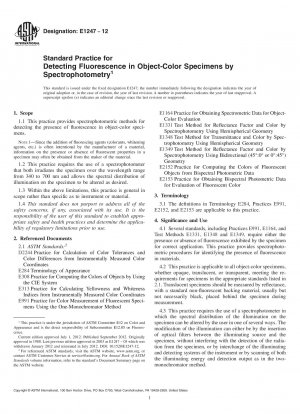ASTM E1247-12
Standard Practice for Detecting Fluorescence in Object-Color Specimens by Spectrophotometry
- Standard No.
- ASTM E1247-12
- Release Date
- 2012
- Published By
- American Society for Testing and Materials (ASTM)
- Status
- Replace By
- ASTM E1247-12(2017)
- Latest
- ASTM E1247-12(2023)
- Scope
Several standards, including Practices E991, E1164, and Test Methods E1331, E1348 and E1349, require either the presence or absence of fluorescence exhibited by the specimen for correct application. This practice provides spectrophotometric procedures for identifying the presence of fluorescence in materials.
This practice is applicable to all object-color specimens, whether opaque, translucent, or transparent, meeting the requirements for specimens in the appropriate standards listed in 2.1. Translucent specimens should be measured by reflectance, with a standard non-fluorescent backing material, usually but not necessarily black, placed behind the specimen during measurement.
This practice requires the use of a spectrophotometer in which the spectral distribution of the illumination on the specimen can be altered by the user in one of several ways. The modification of the illumination can either be by the insertion of optical filters between the illuminating source and the specimen, without interfering with the detection of the radiation from the specimen, or by interchange of the illuminating and detecting systems of the instrument or by scanning of both the illuminating energy and detection output as in the two-monochromator method.
The confirmation of the presence of fluorescence is made by the comparison of spectral curves, color difference, or single parameter difference such as ΔY between the measurements.
Note 28212;In editions of E1247 - 92 and earlier, the test of fluorescence was the two sets of spectral transmittances or radiance factor (reflectance factors) differ by 1 % of full scale at the wavelength of greatest difference.
Either bidirectional or hemispherical instrument geometry may be used in this practice. The instrument must be capable of providing either broadband (white light) irradiation on the specimen or monochromatic irradiation and monochromatic detection.
This practice describes methods to detect the presence of fluorescence only. It does not address the issue of whether the fluorescence makes a significant or insignificant contribution to the colorimetric properties of the specimen for any given application. The user must determine the practical significance of the effect of fluorescence on the color measurement.
1.1 This practice provides spectrophotometric methods for detecting the presence of fluorescence in object-color specimens.
Note 18212;Since the addition of fluorescing agents (colorants, whitening agents, etc.) is often intentional by the manufacturer of a material, information on the presence or absence of fluorescent properties in a specimen may often be obtained from the maker of the material.
1.2 This practice requires the use of a spectrophotometer that both irradiates the specimen over the wavelength range from 340 to 700 nm and allows the spectral distribution of illumination on the specimen to be altered as desired.
1.3 Within the above limitations, this practice is general in scope rather than specific as to instrument or material.
1.4 This standard does not purport to address all of the safety concerns, if any, associated with its use. It is the responsibility of the user of this standard t......
ASTM E1247-12 Referenced Document
- ASTM D2244 Standard Test Method for Calculation of Color Differences From Instrumentally Measured Color Coordinates
- ASTM E1164 Standard Practice for Obtaining Spectrophotometric Data for Object-Color Evaluation
- ASTM E1331 Standard Test Method for Reflectance Factor and Color by Spectrophotometry Using Hemispherical Geometry
- ASTM E1348 Standard Test Method for Transmittance and Color by Spectrophotometry Using Hemispherical Geometry
- ASTM E1349 Standard Test Method for Reflectance Factor and Color by Spectrophotometry Using Bidirectional Geometry
- ASTM E2152 Standard Practice for Computing the Colors of Fluorescent Objects from Bispectral Photometric Data
- ASTM E2153 Standard Practice for Obtaining Bispectral Photometric Data for Evaluation of Fluorescent Color
- ASTM E284 Standard Terminology of Appearance
- ASTM E308 Standard Practice for Computing the Colors of Objects by Using the CIE System
- ASTM E313 Standard Practice for Calculating Yellowness and Whiteness Indices from Instrumentally Measured Color Coordinates
- ASTM E991 Standard Practice for Color Measurement of Fluorescent Specimens
ASTM E1247-12 history
- 2023 ASTM E1247-12(2023) Standard Practice for Detecting Fluorescence in Object-Color Specimens by Spectrophotometry
- 2017 ASTM E1247-12(2017) Standard Practice for Detecting Fluorescence in Object-Color Specimens by Spectrophotometry
- 2012 ASTM E1247-12 Standard Practice for Detecting Fluorescence in Object-Color Specimens by Spectrophotometry
- 2003 ASTM E1247-03 Standard Practice for Detecting Fluorescence in Object-Color Specimens by Spectrophotometry
- 2000 ASTM E1247-92(2000) Standard Test Method for Identifying Fluorescence in Object-Color Specimens by Spectrophotometry
